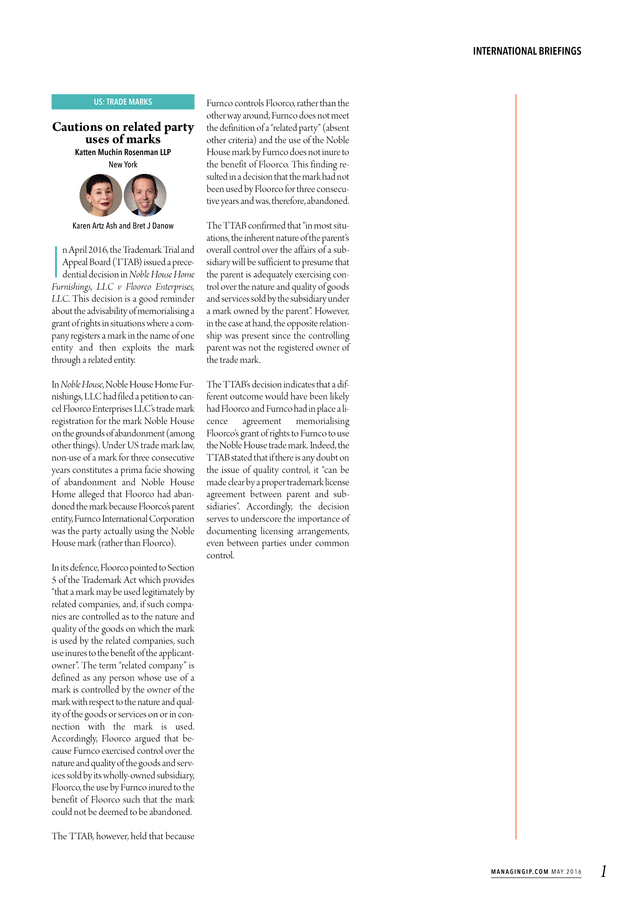Description
INTERNATIONAL BRIEFINGS
US: TRADE MARKS
Cautions on related party
uses of marks
Katten Muchin Rosenman LLP
New York
Karen Artz Ash and Bret J Danow
I
n April 2016, the Trademark Trial and
Appeal Board (TTAB) issued a precedential decision in Noble House Home
Furnishings, LLC v Floorco Enterprises,
LLC. This decision is a good reminder
about the advisability of memorialising a
grant of rights in situations where a company registers a mark in the name of one
entity and then exploits the mark
through a related entity.
In Noble House, Noble House Home Furnishings, LLC had filed a petition to cancel Floorco Enterprises LLC’s trade mark
registration for the mark Noble House
on the grounds of abandonment (among
other things). Under US trade mark law,
non-use of a mark for three consecutive
years constitutes a prima facie showing
of abandonment and Noble House
Home alleged that Floorco had abandoned the mark because Floorco’s parent
entity, Furnco International Corporation
was the party actually using the Noble
House mark (rather than Floorco).
Furnco controls Floorco, rather than the
other way around, Furnco does not meet
the definition of a “related party” (absent
other criteria) and the use of the Noble
House mark by Furnco does not inure to
the benefit of Floorco. This finding resulted in a decision that the mark had not
been used by Floorco for three consecutive years and was, therefore, abandoned.
The TTAB confirmed that “in most situations, the inherent nature of the parent’s
overall control over the affairs of a subsidiary will be sufficient to presume that
the parent is adequately exercising control over the nature and quality of goods
and services sold by the subsidiary under
a mark owned by the parent”.
However, in the case at hand, the opposite relationship was present since the controlling parent was not the registered owner of the trade mark. The TTAB’s decision indicates that a different outcome would have been likely had Floorco and Furnco had in place a licence agreement memorialising Floorco’s grant of rights to Furnco to use the Noble House trade mark. Indeed, the TTAB stated that if there is any doubt on the issue of quality control, it “can be made clear by a proper trademark license agreement between parent and subsidiaries”. Accordingly, the decision serves to underscore the importance of documenting licensing arrangements, even between parties under common control. In its defence, Floorco pointed to Section 5 of the Trademark Act which provides “that a mark may be used legitimately by related companies, and, if such companies are controlled as to the nature and quality of the goods on which the mark is used by the related companies, such use inures to the benefit of the applicantowner”.
The term “related company” is defined as any person whose use of a mark is controlled by the owner of the mark with respect to the nature and quality of the goods or services on or in connection with the mark is used. Accordingly, Floorco argued that because Furnco exercised control over the nature and quality of the goods and services sold by its wholly-owned subsidiary, Floorco, the use by Furnco inured to the benefit of Floorco such that the mark could not be deemed to be abandoned. The TTAB, however, held that because M A N A G I N G I P. C O M M A Y 2 0 1 6 1 . INTERNATIONAL BRIEFINGS 2 M A N A G I N G I P. C O M M A Y 2 0 1 6 .
However, in the case at hand, the opposite relationship was present since the controlling parent was not the registered owner of the trade mark. The TTAB’s decision indicates that a different outcome would have been likely had Floorco and Furnco had in place a licence agreement memorialising Floorco’s grant of rights to Furnco to use the Noble House trade mark. Indeed, the TTAB stated that if there is any doubt on the issue of quality control, it “can be made clear by a proper trademark license agreement between parent and subsidiaries”. Accordingly, the decision serves to underscore the importance of documenting licensing arrangements, even between parties under common control. In its defence, Floorco pointed to Section 5 of the Trademark Act which provides “that a mark may be used legitimately by related companies, and, if such companies are controlled as to the nature and quality of the goods on which the mark is used by the related companies, such use inures to the benefit of the applicantowner”.
The term “related company” is defined as any person whose use of a mark is controlled by the owner of the mark with respect to the nature and quality of the goods or services on or in connection with the mark is used. Accordingly, Floorco argued that because Furnco exercised control over the nature and quality of the goods and services sold by its wholly-owned subsidiary, Floorco, the use by Furnco inured to the benefit of Floorco such that the mark could not be deemed to be abandoned. The TTAB, however, held that because M A N A G I N G I P. C O M M A Y 2 0 1 6 1 . INTERNATIONAL BRIEFINGS 2 M A N A G I N G I P. C O M M A Y 2 0 1 6 .













